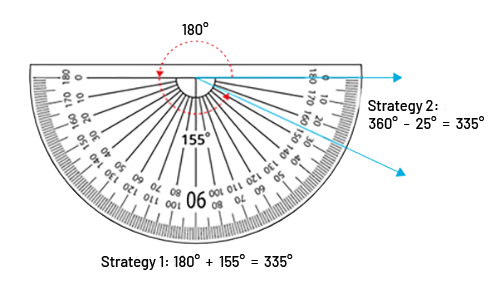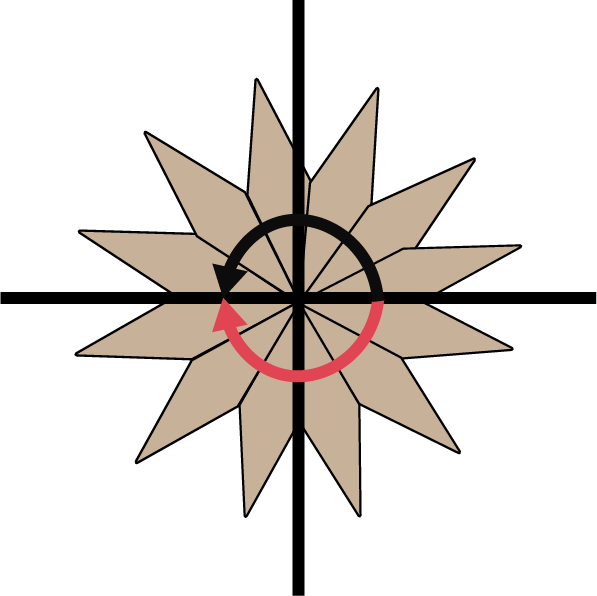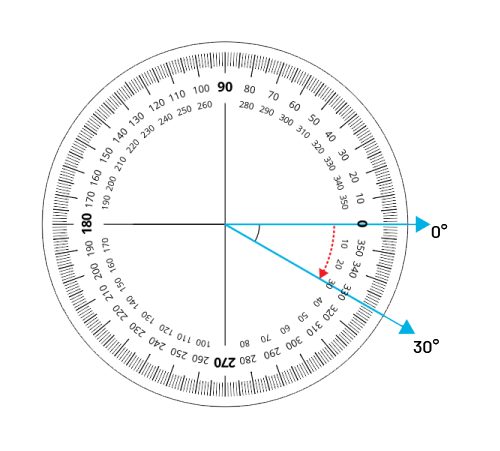E2.2 Use a protractor to measure and construct angles up to 360°, and state the relationship between angles that are measured clockwise and those that are measured counterclockwise.
Skill: Using a Protractor to Measure
The accuracy of the measurement depends largely on whether or not the measurement tool is used correctly. To help students understand the correct way to use a given measuring tool, teachers can first model using it.
To properly use a protractor, you must:
- place the protractor on the angle to be measured, with the zero line (not the bottom of the protractor) aligned with one of the rays. Position the point of origin (usually indicated by a line or a hole) on the vertex of the angle.
- read the measurement, in degrees (for example, 60°), by locating where the scale and the second ray of the angle overlap.
Source: translated from Guide d’enseignement efficace des mathématiques, de la 4e à la 6e année, Mesure, p. 98.
Skill: Using a Protractor to Construct Angles up to 360°
Many common protractors are semi-circular, which means that their scale can only draw up to 180 degrees. There are two strategies for drawing a reflex angle (greater than 180°):
-
draw a straight angle (180°) and measure the angle beyond the straight angle in order to add it (strategy 1);
-
draw a straight angle (180°). Subtract the measurement from the remaining angle of 360° and add it to the straight angle (strategy 2).
 Image a protractor is measuring an angle. Above the protractor is written: 180 degrees. Below the protractor is written: strategy one: 180 degrees plus 155 degrees equals 335 degrees. To the right of the protractor is written: 360 degrees minus 25 degrees equals 335 degrees.
Image a protractor is measuring an angle. Above the protractor is written: 180 degrees. Below the protractor is written: strategy one: 180 degrees plus 155 degrees equals 335 degrees. To the right of the protractor is written: 360 degrees minus 25 degrees equals 335 degrees.
Source: The Ontario Curriculum. Mathematics, Grades 1-8 Ontario Ministry of Education, 2020.
Skill: Determining the Relationship between Angles Measured Clockwise and Angles Measured Counterclockwise
One degree is a very small angle and is a standard unit of angle measurement. A complete circle has 360 degrees.

Generally, a protractor has two scales to make it easier to read the degrees of angles measured clockwise and counterclockwise.
Measuring Clockwise and Counterclockwise Angles
- 90° angle, measured counterclockwise
- 270° angle, measured clockwise
”If the black angle measures 90°, I know that the red angle must measure 270° because when the measurements of the two angles are added together, we get 360° or a circle.“
 Image two perpendicular line segments placed atop a figure made up of parallelograms. There is an arrow circling the centre, starting from the vertical line.
Image two perpendicular line segments placed atop a figure made up of parallelograms. There is an arrow circling the centre, starting from the vertical line.
180° angle, measured counterclockwise and 180° angle, measured clockwise
 Image Two perpendicular line segments placed atop a figure made up of parallelograms. There is an arrow circling the centre, starting from the horizontal line.
Image Two perpendicular line segments placed atop a figure made up of parallelograms. There is an arrow circling the centre, starting from the horizontal line.
Measure 30° Clockwise with a Circular Protractor

Measure 330° Counterclockwise with a Circular Protractor
 Image A circular protractor measuring an angle of 30 degrees. There is a doted red line which measures the external angle counter-clockwise to the needles of a watch.
Image A circular protractor measuring an angle of 30 degrees. There is a doted red line which measures the external angle counter-clockwise to the needles of a watch.
Source: The Ontario Curriculum. Mathematics, Grades 1-8 Ontario Ministry of Education, 2020.
